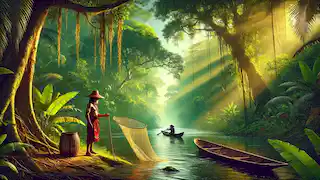In the heart of the Amazon rainforest, where the towering trees stretch toward the heavens and the dense foliage shrouds the world in green, lives a community deeply connected to the land and its pulse. These people, known as the Caboclos, are the children of the Amazon, an intricate blend of indigenous heritage and colonial influence. For centuries, they have lived in harmony with the world's largest tropical forest, cultivating a way of life that mirrors the rhythms of the river and the rainforest itself.
The Amazon rainforest, often called the "lungs of the Earth," is not just a dense, wild jungle teeming with wildlife, but a living, breathing ecosystem that supports millions of lives. Among them, the Caboclos stand out as guardians of this sacred land, preserving a culture that bridges two worlds—ancient and modern, indigenous and colonized. Their existence is a testament to resilience, adaptation, and the profound connection humans can forge with nature. The origins of the Caboclos date back to the 16th century, when the Portuguese explorers first set foot in the Amazon basin. These early European settlers, seeking to establish colonies and extract wealth from the land, encountered the indigenous peoples of the rainforest, who had lived there for thousands of years. Over time, the two groups began to mix, leading to the birth of the Caboclos—a people who inherited the knowledge and wisdom of their indigenous ancestors, as well as the cultural influences of the Portuguese settlers. The term "Caboclo" itself is derived from the Tupi-Guarani word "ka'abok," which means "one who comes from the forest." It was initially used to describe people of mixed European and indigenous ancestry, but over the centuries, it has come to represent a distinct cultural identity. The Caboclos adopted many of the traditional practices of the indigenous tribes, including their methods of hunting, fishing, and farming, but they also incorporated elements of European culture, such as Christianity and Portuguese language. In their small wooden houses, built on stilts to protect them from the seasonal floods of the Amazon River, the Caboclos developed a way of life that was both sustainable and deeply connected to the natural world around them. They learned to read the river's moods, to navigate the dense forests, and to harvest the fruits of the land without depleting its resources. For the Caboclos, the Amazon was not just a place to live—it was a living entity, a source of life and a spiritual guide. For the Caboclos, the Amazon River is more than just a body of water—it is the lifeblood of their world. The river flows through the heart of the rainforest, shaping the land and the lives of those who live along its banks. The Caboclos have learned to live in harmony with the river, relying on its bounty for food, transportation, and even their spiritual practices. Fishing is one of the most important activities for the Caboclos, and it is a skill that has been passed down through generations. Using simple tools like handmade nets and spears, they catch a wide variety of fish from the river, including the pirarucu, one of the largest freshwater fish in the world. The Caboclos are expert fishermen, knowing when and where to find the best catches, but they are also mindful of the need to preserve the river's ecosystem. They fish only what they need, ensuring that the river's resources will continue to sustain future generations. In addition to fishing, the Caboclos cultivate crops along the river's fertile banks. Using traditional slash-and-burn techniques, they clear small patches of land to plant manioc, a staple food in their diet. Manioc, also known as cassava, is a hardy root vegetable that thrives in the Amazon's nutrient-poor soil. The Caboclos grind the roots into flour, which they use to make bread and other foods, providing a reliable source of nutrition even in the harshest conditions. But the river is not just a source of sustenance—it is also a place of spiritual significance. The Caboclos believe that the river is home to powerful spirits, known as encantados, who can take the form of dolphins, snakes, or even human beings. These spirits are both benevolent and malevolent, capable of helping or harming those who encounter them. The Caboclos offer prayers and offerings to the encantados, seeking their protection and guidance as they navigate the river's ever-changing waters. While the Amazon River sustains the Caboclos, the rainforest provides them with a wealth of resources. The Caboclos are expert foragers, knowing how to find fruits, nuts, and medicinal plants hidden in the dense jungle. They gather Brazil nuts, a highly prized commodity, from the towering trees that dominate the forest canopy, and they collect a variety of fruits, including açai, guava, and cupuaçu, which provide both food and income. The forest is also home to countless animals, many of which the Caboclos hunt for food. Using traditional methods, such as bows and arrows or blowguns, they hunt small game like monkeys, birds, and capybaras. The Caboclos have a deep respect for the animals they hunt, and they follow a code of ethics that ensures they only take what they need to survive. Hunting is not a sport for the Caboclos—it is a means of survival, and they are careful to maintain the balance between predator and prey. But the forest is more than just a source of food—it is also a place of healing. The Caboclos have inherited a wealth of knowledge about the medicinal plants of the Amazon from their indigenous ancestors. They know which plants can cure fevers, treat infections, or alleviate pain, and they use this knowledge to treat illnesses and injuries in their community. Many of the plants they use, such as the bark of the cinchona tree, which contains quinine, have been used for centuries to treat diseases like malaria. The Caboclos also believe that the forest is home to powerful spirits and deities. They perform rituals and ceremonies to honor these spirits, seeking their protection and blessings. The forest, like the river, is a living entity to the Caboclos, and they treat it with the utmost respect, knowing that their survival depends on its continued health. As the modern world encroaches on the Amazon, the Caboclos find themselves at a crossroads. The expansion of agriculture, logging, and mining in the region has led to widespread deforestation, threatening the delicate balance of the rainforest ecosystem. The Caboclos, who have lived sustainably in the forest for centuries, now face the challenge of preserving their way of life in the face of rapid environmental change. Many Caboclo communities have been forced to adapt to the changing world, seeking new ways to make a living in a globalized economy. Some have turned to tourism, offering guided tours of the rainforest to visitors from around the world. Others have embraced sustainable agriculture, growing crops like cacao and coffee for export. Still, others have become involved in conservation efforts, working with environmental organizations to protect the Amazon and its wildlife. But despite these changes, the Caboclos remain deeply connected to their roots. They continue to practice the traditions of their ancestors, passing down their knowledge of the land and its resources to the next generation. For the Caboclos, the Amazon is not just a place to live—it is their identity, their culture, and their home. The future of the Caboclos is uncertain, but they are determined to continue their way of life in the face of adversity. They are resilient people, having survived centuries of colonization, exploitation, and environmental change, and they remain committed to preserving their culture and their connection to the land. In recent years, there has been growing recognition of the importance of the Caboclos and other traditional communities in the fight to protect the Amazon rainforest. Governments and environmental organizations have begun to acknowledge the role that indigenous and local communities play in preserving the biodiversity of the region, and efforts are being made to involve the Caboclos in conservation initiatives. The Caboclos are not just passive victims of environmental degradation—they are active participants in the movement to save the Amazon. They are the guardians of the rainforest, and their knowledge and experience are invaluable in the fight to protect this vital ecosystem. As the world begins to realize the importance of the Amazon in combating climate change, the Caboclos will play a key role in ensuring its survival. But for the Caboclos, the fight to save the Amazon is not just about protecting the environment—it is about preserving their way of life. The forest and the river are integral to their identity, and they will continue to defend their land and their culture, just as their ancestors did before them. The story of the Caboclos is one of resilience, adaptation, and connection to the natural world. They are a people who have lived in harmony with the Amazon for centuries, relying on its resources for survival while also protecting its delicate ecosystem. In the face of modern challenges, the Caboclos continue to uphold their traditions and fight to preserve their way of life. Their story is a reminder of the profound connection between humans and the natural world, and the importance of protecting both for future generations.The Birth of the Caboclos
The River's Embrace
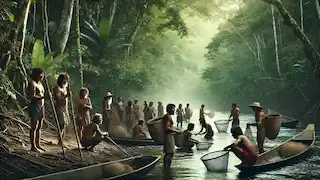
The Forest’s Bounty
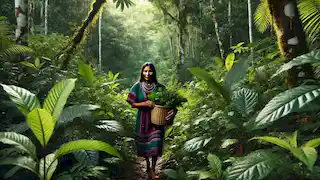
The Changing World
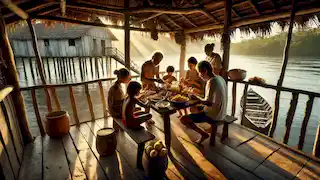
The Future of the Caboclos
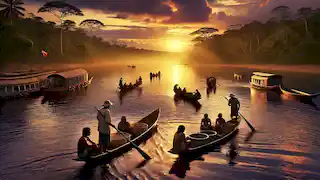
Conclusion
